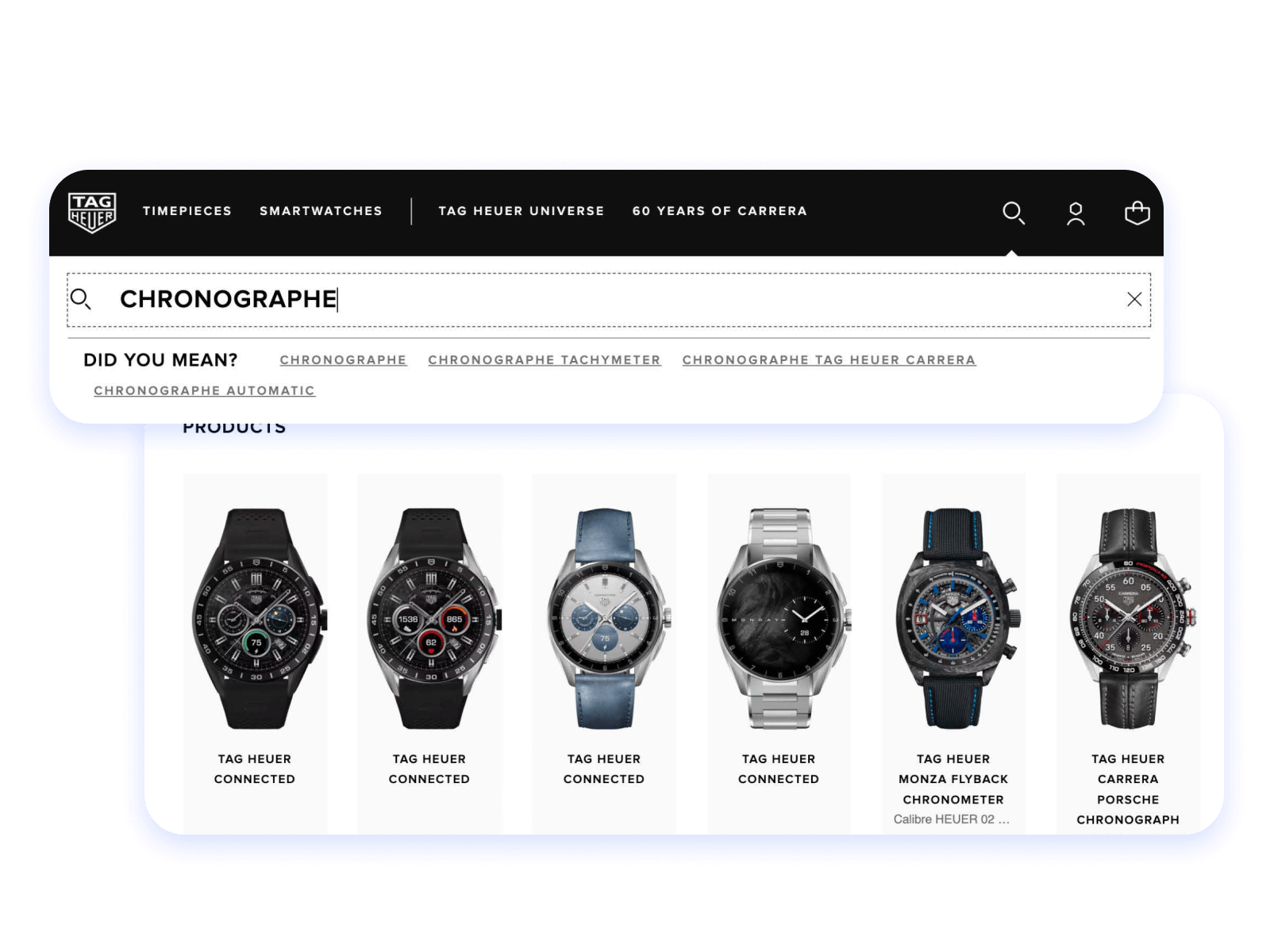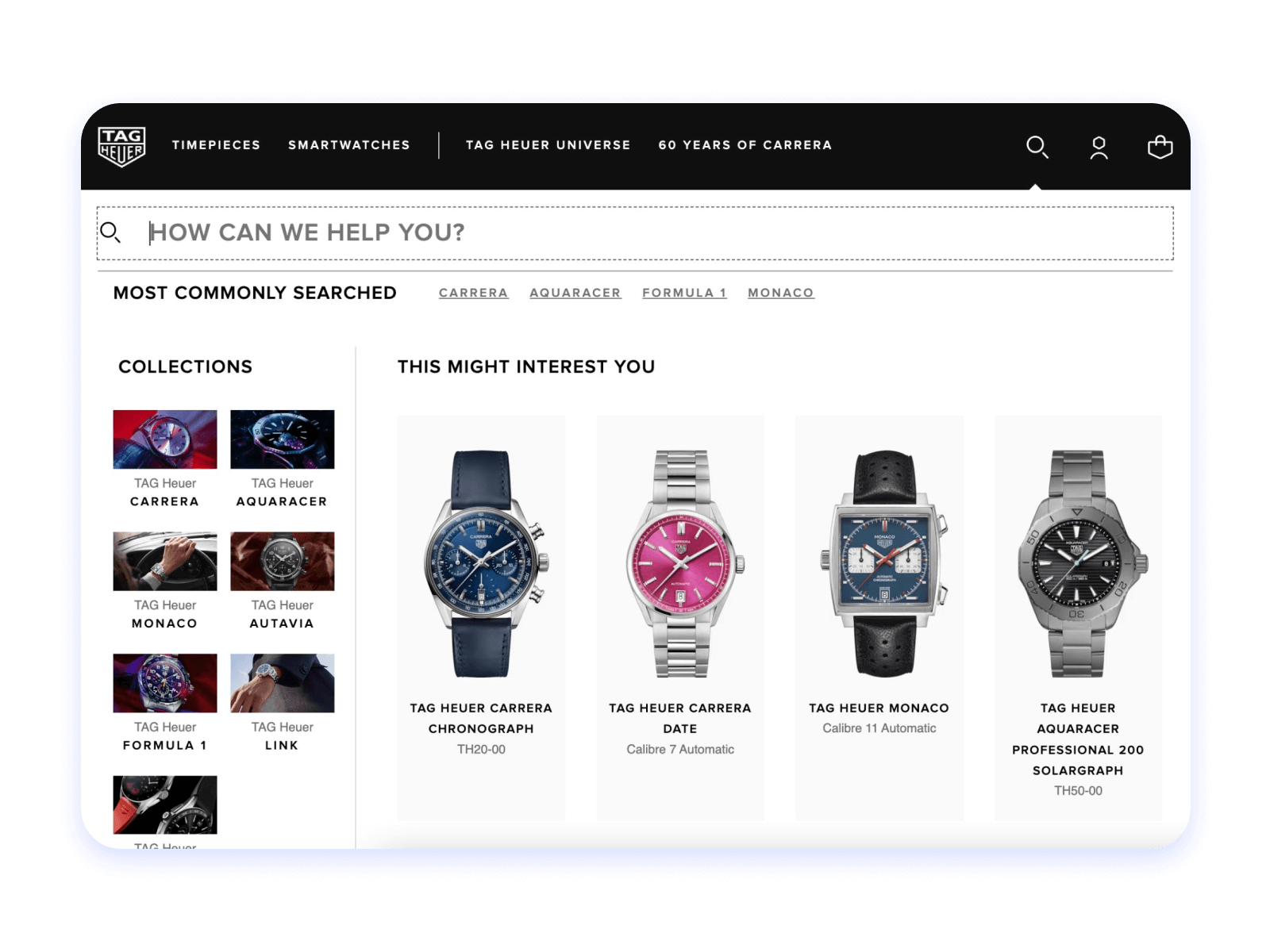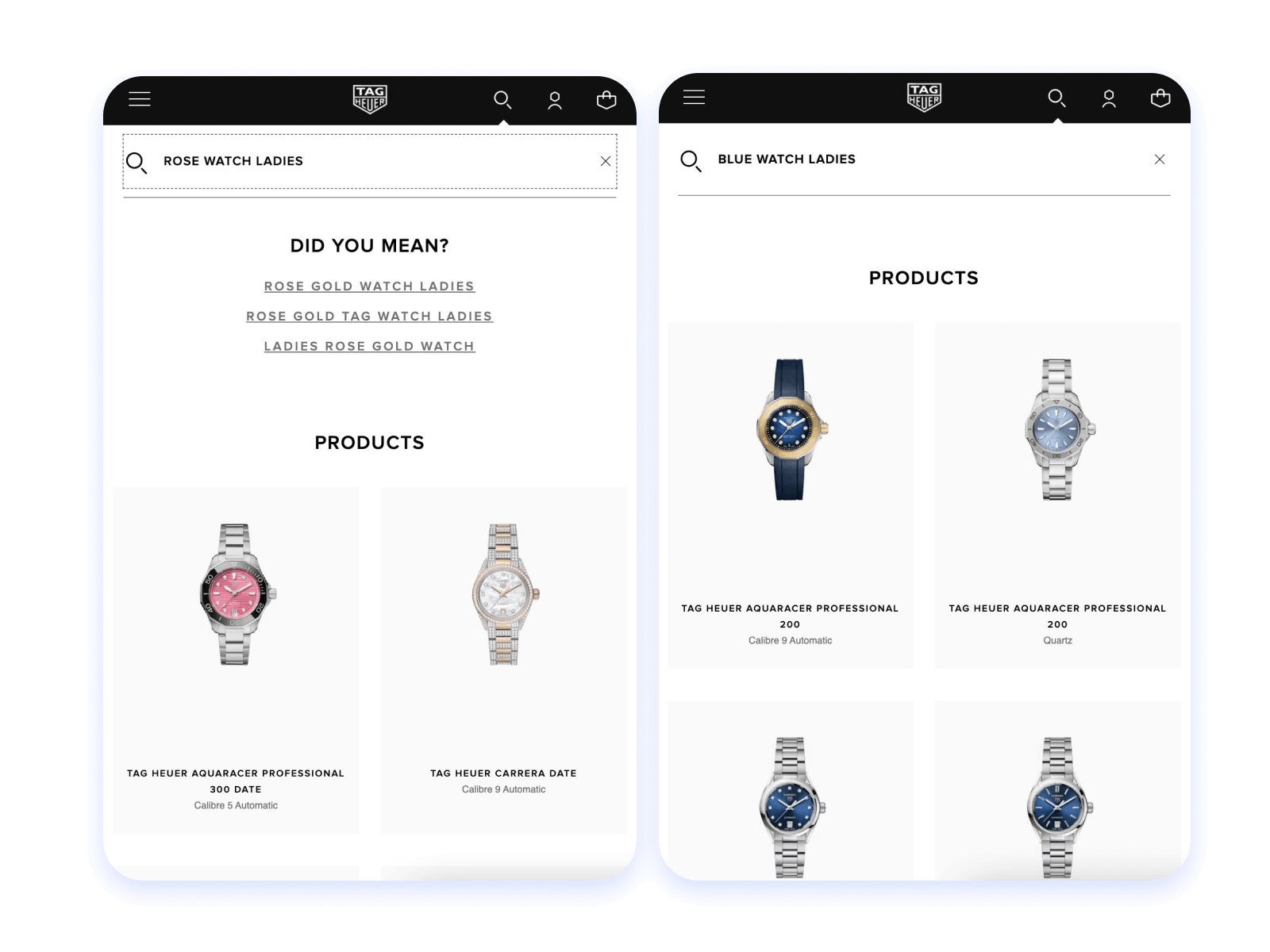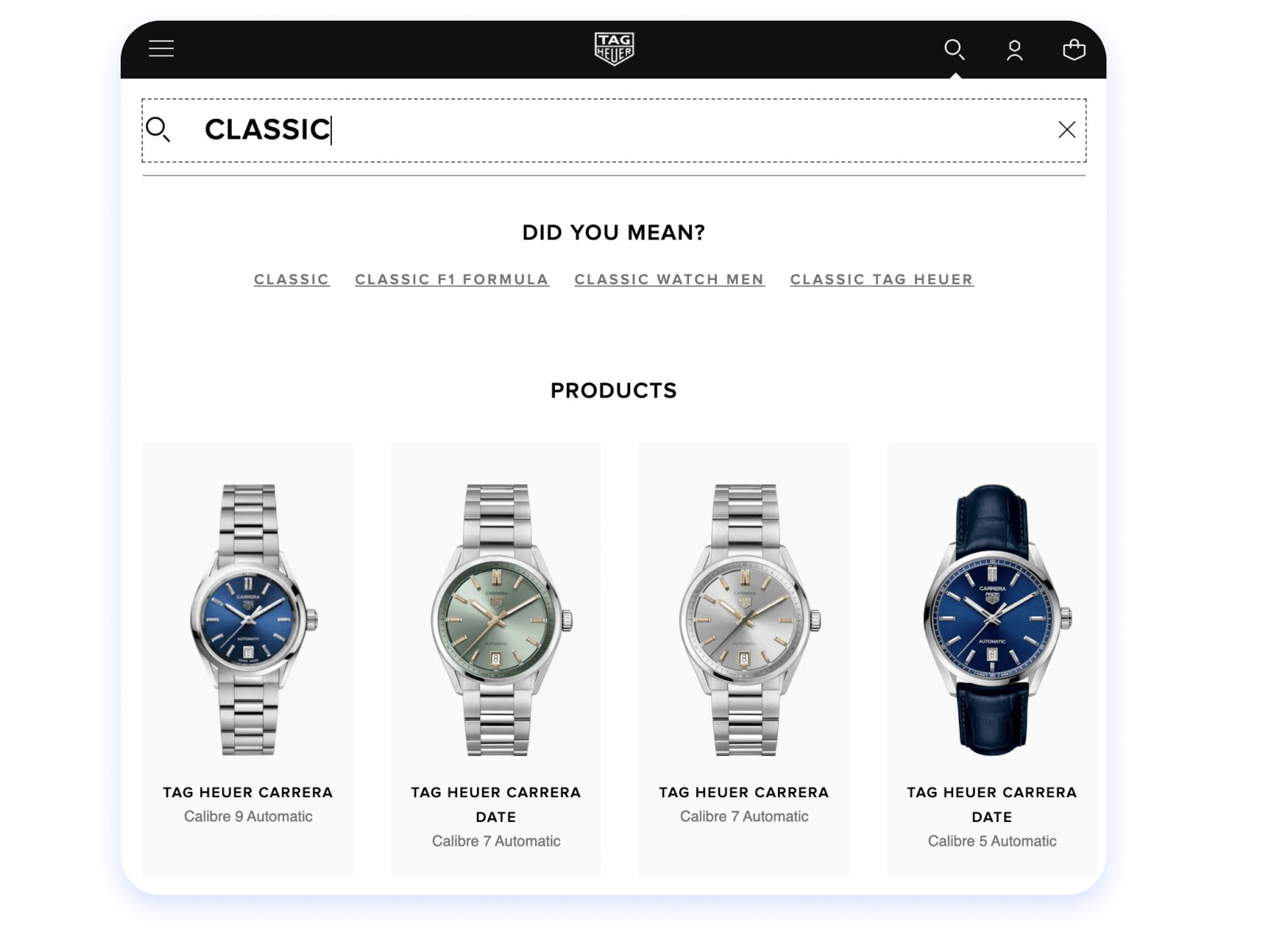TAG Heuer has a history of chronographic innovation dating back to 1860. Acquired by luxury goods brand LVMH in 1999, they are also a fashion and design trend leader. Their lengthy back catalogue of products was spread across multiple websites, and their search function was insufficient to surface product details for customers. When the time came to completely transform their digital approach, they needed a search platform that was both swift and powerful.

When Every Fraction of a Second Counts: Why TAG Heuer chose Algolia for Search and Discovery
“Every user experience is different: there’s nothing specific to luxury, just good sense. In our opinion, that’s the answer to good UX – the user experience must be simple and straightforward. And we transcribe this into the design of our website.”
Pascal Sardella
Digital Platforms Administrator @ TAG HeuerSummary

B2C Ecommerce
La Chaux-de-Fonds, Switzerland
since 2019
Omnichannel experience, Salesforce Commerce Cloud cartridge/integration, Dynamic re-ranking, Rules, Synonym Management, Analytics
Creating a full omnichannel experience across their in-store and online channels
Higher increase in search sessions, longer search sessions
Conversion rates double when using Search
80% of customer visits via mobile
8 sites and 11 languages
The challenges
1.
Vast back catalogue of products spread across multiple sites
2.
A search function limited to product name or ID
3.
Multiple languages (11) to integrate
4.
A need to integrate with other platforms
The solution
1.
Chose Algolia to have a search platform, rather than a search function
2.
Implemented dynamic Re-ranking, Rules, Analytics, Visual Editor, Salesforce Commerce Cloud cartridge integration
3.
Used by digital and merchandiser teams
The result
1.
Exceptionally swift platform integration
2.
Increase in search sessions, both in number and in length
3.
Conversion rates double when using search
4.
A true, immersive, omnichannel experience for customers
TAG Heuer has been on the forefront of technological design and innovation since Edouard Heuer first opened his watchmaking shop in 1860. His 1869 patent for a crown-operated keyless winding system revolutionized timekeeping for the industrial age. Known for impeccable stopwatches and innovative wrist chronographs, the Heuer family continued to make advancements in timekeeping, enriching industry, medicine, science, sports, and transportation for decades.
Under the guidance and ownership of Techniques d’Avant-Garde, Heuer moved beyond mechanical chronographs into watchmaking for the 21st century. French luxury goods group LVMH acquired TAG Heuer in 1999.
Since then, TAG Heuer has continued to redefine the world of precision and luxury watches and chronographs, drawing on its vast catalogue of past models and anticipating the future with smartwatches and other advanced technological creations.
Today TAG Heuer manufactures watches and chronographs renowned for style, durability, and extraordinary precision. With an international array of retail locations and individual customers from all around the globe, TAG Heuer needed a search platform that fit its needs for speed, accuracy, and brilliant design.
Innovation and Precision
Pascal is responsible for maintaining that digital ecosystem in consultation with partners and stakeholders. He is also the product owner for digital solutions and works with the digital and e-commerce teams maintaining the TAG Heuer websites.
TAG Heuer wanted to create an immersive online user experience that would last throughout the entire customer journey. “We need to have enough space for our users to take time to discover content, discover products, and also take some risks during the journey on our website.” Since almost 80% of their customers visit via mobile, they also wanted to improve the mobile experience.
In 2019, TAG Heuer enacted a digital and agile transformation by switching their platform to Salesforce Commerce Cloud. That transformation was built on three foundational bricks. First, their Product Information Management (PIM) is the source of product information across all channels. Next, their Digital Asset Management (DAM) is the media source for PIM and Salesforce Commerce Cloud. Their third brick is Algolia, their blazing fast search engine.
“We’ve had multiple innovations when it comes to time measurement, but we also try to be innovative in the way we conceive our digital ecosystem and our website.” Pascal Sardella Digital Platforms Administrator at TAG Heuer
Fractional Seconds Count
“Remember the context,” says Pascal . “The watch industry is very specific. Because of our position, and the way we try to be innovative, we need a fast time-to-market.” In today’s world, luxury watches are also fashion items: TAG Heuer creates and follows fashion trends as well as technology trends. Changes and updates are frequently required — and must be swift and seamless.
Before the switch to Algolia, TAG Heuer didn’t have a search platform. Instead, their search function relied solely on product name or ID. Pascal recounts having to load the product name and ID with everything they could to make it surface when customers searched. “I can tell you; it was not very efficient. Content was not reachable.” With several linked sites to navigate, and 11 languages to coordinate, they needed a better solution.
When looking for a new search solution, speed was their primary criteria. “Speed of search request, speed of execution. This is why our attention turned to Algolia,” Pascal says. “We also wanted a tool with a simple UI and dynamic rules, to manage our assortment of products in a progressive way. And we need to easily share access with our e-commerce team and merchandisers.” Algolia’s proven integration capabilities were a huge advantage.

With their omnichannel evolution, TAG Heuer has also used Algolia to imbed product tiles into their immersive landing pages. “Our creative digital content partner decided to use the Algolia API to pick product information,” says Pascal, adding “Algolia’s API was easier to use.” Additionally, TAG Heuer refactored their store locator in 2021. “We decided to integrate the store locator search in Algolia. This allows us to get more to the retail channel.” They also leveraged Algolia’s features to launch a new, direct-to-customer program that came with a warranty extension. “In order for the extension to work, we had to create a new search engine within our customer accounts. This new search engine is also managed by Algolia.”

Excellence Across the Board
The digital platform team is the anchor of the marketing teams, IT teams, and the e-commerce team. “We have a touchpoint every week with our merchandising team,” Pascal says. “We work with the team to make the tool more dynamic. We have constant feedback from merchandisers, happy with the way Algolia is evolving, and the way they can easily manage their catalogues. It makes their lives easier.”
Pascal looks forward to finding new ways to integrate Algolia into the customer experience. He plans to implement tracking in the very near future. “We’re also looking forward to leveraging new tools, especially the artificial intelligence (AI) and the A/B testing – tracking will benefit from those.” Their new direct-to-customer app is headless, proving Algolia can help them connect with headless technologies in ways they haven’t yet considered.

Speed, usability, and ease of adoption are the attributes Pascal likes most about Algolia. Their onboarding experience was both smooth and incredibly fast. “Our developers got their hand to the gun quickly.” He deeply appreciates how Algolia allows them to assess their SEO, as well as the company’s approach to outreach and support. “The documentation is really straightforward, but if we really need to contact Algolia, there’s always someone to help us tackle our challenges.”
Integrating Algolia brought immediate results. “When we compare sessions on our website with and without search, the sessions with search have a conversion rate more than double our usual.” More importantly, with Algolia TAG Heuer is able to provide a true omnichannel experience for their customers, with cohesive search available both in store and digital locations.
TAG Heuer believes that victories in life result from the choices made every fraction of a second. Which is why they are more than satisfied with their choice of search platform. "We assessed the market and got in touch with other brands. We were confident that Algolia would fit our needs.”

Recommended stories
Powered by Algolia AI Recommendations
Algolia experts can help you take your site experience to the next level
Get a customized demo from our search experts today


